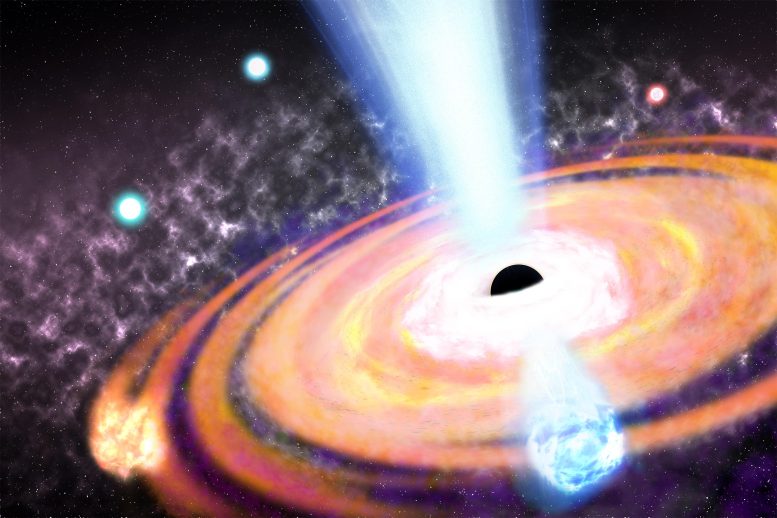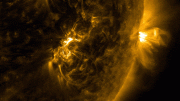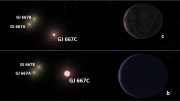
An illustration of a magnetic field generated by a supermassive black hole in the early universe, showing turbulent plasma outflows that help turn nearby gas clouds into stars. New findings suggest this process might be responsible for accelerated star formation in the first 50 million years of the universe. Credit: Roberto Molar Candanosa/Johns Hopkins University
Which came first: Black holes or galaxies? Findings ‘completely shake up’ what we know about galaxy formation.
Black holes not only existed at the dawn of time, they birthed new stars and supercharged galaxy formation, a new analysis of James Webb Space Telescope data suggests.
The insights upend theories of how black holes shape the cosmos, challenging classical understanding that they formed after the first stars and galaxies emerged. Instead, black holes might have dramatically accelerated the birth of new stars during the first 50 million years of the universe, a fleeting period within its 13.8 billion—year history.
Revising Cosmic Theories
“We know these monster black holes exist at the center of galaxies near our Milky Way, but the big surprise now is that they were present at the beginning of the universe as well and were almost like building blocks or seeds for early galaxies,” said lead author Joseph Silk, a professor of physics and astronomy at Johns Hopkins University and at Institut of Astrophysics, Paris, Sorbonne University. “They really boosted everything, like gigantic amplifiers of star formation, which is a whole turnaround of what we thought possible before—so much so that this could completely shake up our understanding of how galaxies form.”
The work is newly published in the Astrophysical Journal Letters.
Distant galaxies from the very early universe, observed through the Webb telescope, appear much brighter than scientists predicted and reveal unusually high numbers of young stars and supermassive black holes, Silk said.
Black Holes and Galaxy Formation
Conventional wisdom holds that black holes formed after the collapse of supermassive stars and that galaxies formed after the first stars lit up the dark early universe. However, the analysis by Silk’s team suggests that black holes and galaxies coexisted and influenced each other’s fate during the first 100 million years. If the entire history of the universe were a 12-month calendar, those years would be like the first days of January, Silk said.
“We’re arguing that black hole outflows crushed gas clouds, turning them into stars and greatly accelerating the rate of star formation,” Silk said. “Otherwise, it’s very hard to understand where these bright galaxies came from because they’re typically smaller in the early universe. Why on earth should they be making stars so rapidly?”
Understanding Black Hole Mechanics
Black holes are regions in space where gravity is so strong that nothing can escape their pull, not even light. Because of this force, they generate powerful magnetic fields that make violent storms, ejecting turbulent plasma and ultimately acting like enormous particle accelerators, Silk said. This process, he said, is likely why Webb’s detectors have spotted more of these black holes and bright galaxies than scientists anticipated.
“We can’t quite see these violent winds or jets far, far away, but we know they must be present because we see many black holes early on in the universe,” Silk explained. “These enormous winds coming from the black holes crush nearby gas clouds and turn them into stars. That’s the missing link that explains why these first galaxies are so much brighter than we expected.”
Silk’s team predicts the young universe had two phases. During the first phase, high-speed outflows from black holes accelerated star formation, and then, in a second phase, the outflows slowed down. A few hundred million years after the big bang, gas clouds collapsed because of supermassive black hole magnetic storms, and new stars were born at a rate far exceeding that observed billions of years later in normal galaxies, Silk said. The creation of stars slowed down because these powerful outflows transitioned into a state of energy conservation, he said, reducing the gas available to form stars in galaxies.
Implications and Future Research
“We thought that in the beginning, galaxies formed when a giant gas cloud collapsed,” Silk explained. “The big surprise is that there was a seed in the middle of that cloud—a big black hole—and that helped rapidly turn the inner part of that cloud into stars at a rate much greater than we ever expected. And so the first galaxies are incredibly bright.”
The team expects future Webb telescope observations, with more precise counts of stars and supermassive black holes in the early universe, will help confirm their calculations. Silk expects these observations will also help scientists piece together more clues about the evolution of the universe.
“The big question is, what were our beginnings? The sun is one star in 100 billion in the Milky Way galaxy, and there’s a massive black hole sitting in the middle, too. What’s the connection between the two?” he said. “Within a year we’ll have so much better data, and a lot of our questions will begin to get answers.”
Reference: “Which Came First: Supermassive Black Holes or Galaxies? Insights from JWST” by Joseph Silk, Mitchell C. Begelman, Colin Norman, Adi Nusser and Rosemary F. G. Wyse, 30 January 2024, The Astrophysical Journal Letters.
DOI: 10.3847/2041-8213/ad1bf0
Authors include Colin Norman and Rosemary F. G. Wyse of Johns Hopkins; Mitchell C. Begelman of University of Colorado and National Institute of Standards and Technology; and Adi Nusser of the Israel Institute of Technology.
The team is supported by the Israel Science Foundation and the Asher Space Research Institute, as well as Eric and Wendy Schmidt by recommendation of the Schmidt Futures program.









When the spacetime bubble first formed baryonic matter precipitated out of the QL soup. We are in that soup and haven’t yet figured out how to see it as it is outside of spacetime. Picture a clear cloudless sky that in almost no time is filled with puffy white clouds. This is how I believe the spacetime bubble of baryons was formed.This would have happened where inflation was assumed to end. As spacetime cooled the baryons condensed first and then gaseous dark matter that makes up the fabric of spacetime cooled. When it reached the temperature at which dark matter condenses the collapsing dark matter vortices gravitationally pulled the baryonic matter with it into denser clouds.
The rapidly forming clouds collapsed into black holes of all sizes and huge stars depending how much baryonic matter pulled into that area by the condensing dark matter. The dark matter that reaches the center of the gravity well circulates back out away from the plane which supplies the angular momentum of the universe. The Dark Matter basically streams into the gravity wells in the early universe making them deeper. During this period the first voids are formed and light is redshifted as it climbs out of the gravity wells where it spends increasingly longer periods of time. The deeper gravity wells in combination with the increasing percentage of time light spends at high redshirts gives the impression that the universe is expanding.
Our universe is a general relativistic universe, which self consistently describe space. There is no imaginary ‘outside’.
The rest may well be fair physics. But it must be quantified to be science, which personal belief isn’t.
The bubble of space-time is the void of space. When the nucleus (bar) of a black hole where matter is accumulated disappears, void.bar.timespace is created. These are bubbles stretching out like a dotted void line at the zz’ horizon of a black hole event. Between voids, there is a region of xy space-time boundary. There is a difference between the same space and time and different space and time.
interesting and surprising article. eill need to check what instruments on JWST can detect block holes that do not emit electromagnetic radiation. assume that detection is based on gravitational effect of BH on light passing nearby that makes it to JWST.
The early black holes that we can observe based on their effects are supermassive black holes that release jets and promote bright star formation episodes in so called AGNs (Active Galactic Nuclei).
“Using the James Webb Space Telescope (JWST), astronomers discovered that when our 13.8-billion-year-old universe was between 4 billion and 6 billion years old, it housed fewer feeding supermassive black holes than previously suspected.
Such supermassive black holes, which can be millions, or even billions, of times as massive as the sun, grow by feasting on matter that surrounds them in the form of flattened disks called accretion disks. These black holes’ gravitational influences also heat that material, thereby emitting tremendous amounts of radiation. When a black hole partakes in this extreme process, the whole region (including those radiation jets) is known as an active galactic nucleus, or AGN.” [Space]
The primordial black hole versus Supermassive black hole (a sign of galaxy) mechanics is what we account today or just after the big bang that who contributed more in the star formation till now.
I’ve always thought what use are black holes and think they could have produced planets suns every thing in the universe not the big bang
No, their accretion disks do not seem to form stars or planets.
That is meanwhile what collapsing molecular clouds are known to do. “Protostars form from molecular clouds consisting primarily of molecular hydrogen.” [Wikipedia]
Joseph Silk has found yet a new vehicle to decry the standard cosmological model successes, which ironically he was an early instigator of. The proposal paper is not surprisingly ending in various hypotheticals about the early universe which are clashing against observations (such as primordial black holes).
““Otherwise, it’s very hard to understand where these bright galaxies came from because they’re typically smaller in the early universe. Why on earth should they be making stars so rapidly?”
There is no lack of quantified hypotheses by groups that have done their homework. An example:
“An international team of astronomers led by UCLA’s Smadar Naoz is doing simulations of early galaxy formation. Their computer programs track the circumstances of galactic births not long after the Big Bang. These “hot off the press” computer models include some new wrinkles. They take into account previously neglected interactions between dark matter and the primordial “stuff” of the Universe. That would be hydrogen and helium gas. The result of the simulations: tiny, bright galaxies that formed more quickly than in computer models that didn’t include those motions.”
[Universe Today, describing the ApJ Letters paper “The Supersonic Project: Lighting Up the Faint End of the JWST UV Luminosity Function”.]
If one squints at the lower right corner of the illustration long enough, an image of Einstein wearing a respirator my appear.